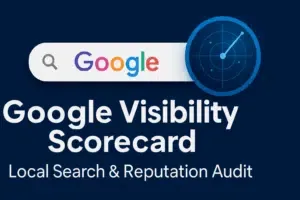How Google’s AI Overviews Are Stealing Your Traffic
Introduction
If your Google rankings and website traffic have suddenly tanked, you’re not alone. Since Google rolled out AI Overviews in Search, many websites have seen click-through rates drop by 15–70%—even when they still rank in the top results.
Why? Because Google is now answering users’ questions directly on the search page, often pulling from multiple sources. This “position zero” AI-generated block hogs the prime real estate and leaves less reason for users to click through to your site.
In this post, we’ll break down:
- Why rankings and traffic have dropped
- What’s changed in Google’s ranking signals in 2025
- How AI Overviews steal clicks
- 15 easy fixes to regain visibility fast
Why Have My Rankings & Traffic Dropped?
- AI Overviews take the top spot: They appear above all organic results, pushing links further down the page.
- Zero-click searches are rising: Many users now get the answer directly in Google and never visit your site.
- Non-branded keywords suffer most: Studies show an average –20% CTR drop for non-branded terms.
- Lower positions hit hardest: Rankings outside the top 3 have seen –27% CTR declines.
- Industry-wide traffic losses are real: Even large outlets like Forbes and CNN report up to 40% traffic drops
What’s Changed in 2025?
From SEO to AEO & GEO
Traditional SEO is no longer enough. We’ve entered the era of Answer Engine Optimization (AEO) and Generative Engine Optimization (GEO) —optimizing so your content gets cited in AI-generated results, not just ranked in organic listings.
The E-E-A-T Factor
Google leans heavily on content that demonstrates:
- Experience (first-hand insights, original data)
- Expertise (subject-matter knowledge)
- Authoritativeness (reputation and credentials)
- Trustworthiness (transparent sources, accurate info)
Structured & Semantic Content
Clean formatting, schema markup, and Q&A-style writing make your content easier for AI to parse and feature in its Overview summaries.
Why AI Overviews Steal Traffic
- They answer questions instantly: No click needed for the user to get a complete answer.
- They dominate visually: with rich blocks of text, images, and citations.
- They blend multiple brands’ content, meaning your insights may appear under someone else’s name.
- They reshape user behavior: People expect answers without leaving the SERP.
Google’s 2025 Ranking Signals (Beyond Links & Keywords)
Google’s algorithms increasingly weigh:
- E-E-A-T signals (credentials, citations, and trust markers)
- Structured data (schema markup for clarity)
- Semantic relevance (contextual match, not just keyword match)
- Citation probability (likelihood of being used in AI responses)
- User engagement metrics (time on site, repeat visits)
- Content freshness (recent, updated information)
- Multimedia integration (video, audio, interactive tools)
15 Easy Fixes to Regain Visibility Fast
- Add a concise answer at the top of each page (TL;DR or summary box).
- Implement schema markup—especially FAQPage, HowTo, and Article.
- Write in plain, conversational language to improve AI parsing.
- Break content into lists, bullet points, and clear headings.
- Showcase E-E-A-T with author bios, credentials, and external citations.
- Include first-hand insights, case studies, and original research.
- Create downloadable resources like templates, calculators, and checklists.
- Optimize for featured snippets to increase your AI Overview inclusion chances.
- Encourage deeper clicks with internal links and “read more” sections.
- Write for questions—use natural Q&A formatting in content.
- Track keywords triggering AI Overviews and optimize those pages first.
- Focus on branded keyword SEO to protect your CTR.
- Repurpose content into video, audio, and infographics for multiple SERP formats.
- Drive traffic off-site via email, social media, and communities.
- Plan an AI-aware content calendar that targets “answer-friendly” topics.
The SEO game has changed. AI Overviews are here to stay—and they’re rewriting how visibility works. But with smart AEO/GEO optimization, a strong E-E-A-T foundation, and consistently structured, fact-driven content, you can still capture your share of the search spotlight.
Summary Box: Beating Google’s AI Overviews in 2025
Key Takeaways:
- AI Overviews now dominate top-of-page visibility. To stay visible, optimize for answer inclusion — not just ranking.
- Content clarity beats length. Use concise headings, bulleted facts, and question-based sections.
- E-E-A-T is non-negotiable. Cite credentials, update timestamps, and show author expertise.
- Structured data fuels AI comprehension. Add FAQ, HowTo, and Author schema to every article.
- Real-world examples matter. Case studies and stats increase your odds of being cited in AI summaries.
- Consistency wins. Regular updates and internal linking signal freshness and authority.
Pro Tip:
Test your content in live AI Overviews weekly. Track which paragraphs Google quotes — then tighten those sections for higher “inclusion quality.”
✅ Want a full AI Overview Optimization Audit to see where you’re losing visibility and how to fix it?
Frequently Asked Questions
Why have my Google rankings and traffic dropped in 2025?
Google’s AI Overviews now appear above organic results, often answering user queries without requiring a click. This shift has reduced click-through rates, especially for non-branded and informational searches.
What is Answer Engine Optimization (AEO) and Generative Engine Optimization (GEO)?
AEO and GEO are strategies to structure your content so AI-driven search features like Google AI Overviews can easily use and cite it. This involves concise answers, schema markup, and strong E-E-A-T signals.
Why are AI Overviews stealing traffic from my website?
AI Overviews display aggregated answers from multiple sources in the most visible position on Google’s search results, reducing the need for users to click on organic listings.
What ranking signals does Google use in 2025 beyond links and keywords?
Google now prioritizes E-E-A-T (experience, expertise, authoritativeness, trustworthiness), structured data, semantic relevance, citation potential, engagement metrics, and content freshness.
What quick fixes help regain visibility after AI Overview traffic loss?
Add concise summaries, use schema markup, write in clear language, format with lists and headings, showcase author credentials, publish first-hand data, and optimize for featured snippets.

Michael Klasno is SERP Sniper – Building local optimized websites for Attorneys, Law Firms and Business Professionals in Houston and Southeast Texas.
Michael Klasno is a consummate Search Engine Optimization (SEO) Specialist with an impressive 20-year tenure in the digital marketing landscape. Throughout two decades, Michael has been at the forefront of evolving website design & SEO strategies, seamlessly integrating the latest trends with time-tested methodologies.
His SEO expertise encompasses a vast array of skills, including keyword research, technical SEO, (both on-page and off-page) Local SEO, Google Business Profile optimization, SEO auditing, competitive analysis, and content strategy formulation.
“By building a cost effective corporate or business website that looks great and has a high conversion rate you can dominate the organic search results.”



